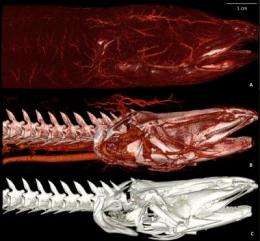Feast and famine: MRI reveals secrets of animal anatomy

Danish scientists have used Computer Tomography (CT) and Magnetic Resonance Imaging (MRI) to investigate internal organs in animals including alligators, snakes and tarantulas.
Images revealed, for the first time non-invasively, how a snake adapts its internal organs in preparation for a big meal and during digestion, until it has disappeared completely.
The scientists think MRI and CT images of animal anatomy could be valuable supplements to traditional textbook sketches, diminishing the need for invasive research and dissections.
The new research, presented on Wednesday 30th June 2010 at the Society for Experimental Biology Annual Meeting in Prague, is the first time the complete digestion cycle of a Burmese Python has been visualised with modern MRI and CT imaging techniques.
'Pythons are renowned for their ability to fast for many months and ingest very large meals', explained Kasper Hansen, from the Aarhus University in Denmark. Modern scanning techniques have shown how extreme adaptations of the internal organs allow the snake to accommodate this 'feast and famine' lifestyle.
Fasting Burmese pythons (Python molurus) were scanned before and at 2, 16, 24, 40, 48, 72 and 132 hours after ingestion of one rat. The succession of images revealed a gradual disappearance of the body of the rat, accompanied by an overall expansion of the intestine, shrinking of the gallbladder, and a 25% increase in heart volume.
The scientists think the technique may be useful in showing the ability of organs to show extreme anatomical adaptations, known as phenotypic flexibility, in other species.
The team used a combination of Computer Tomography (CT), which is suited to hard tissue (bones, teeth, shell etc) and MRI, more suitable for soft tissue, to visualise the entire internal organ structures and vascular systems of their subjects.
"Because of the changes induced by dissection, ordinary illustrations tend to be a bit subjective and sometimes misleading", explained Kasper Hansen. "For example, after opening the dense bone of a turtle shell, the lungs will collapse due to a change in interthoracic pressure".

"Instead, we were able to produce high resolution 3D digital models of animal soft and hard tissue anatomy within hours", explained Henrik Lauridsen, a student in the research team.
The images produced by the techniques could be a valuable tool in future studies of animal anatomy for research and education purposes, according to the scientists.
By choosing the right settings for contrast and light intensity during the scanning process, the scientists were able to highlight specific organs and make them appear in different colours.
Some species such as turtles, swamp eels and bearded dragons were also injected contrasting agents, which allowed the scientists to investigate their vasculature (blood vessels).
Provided by Society for Experimental Biology

















